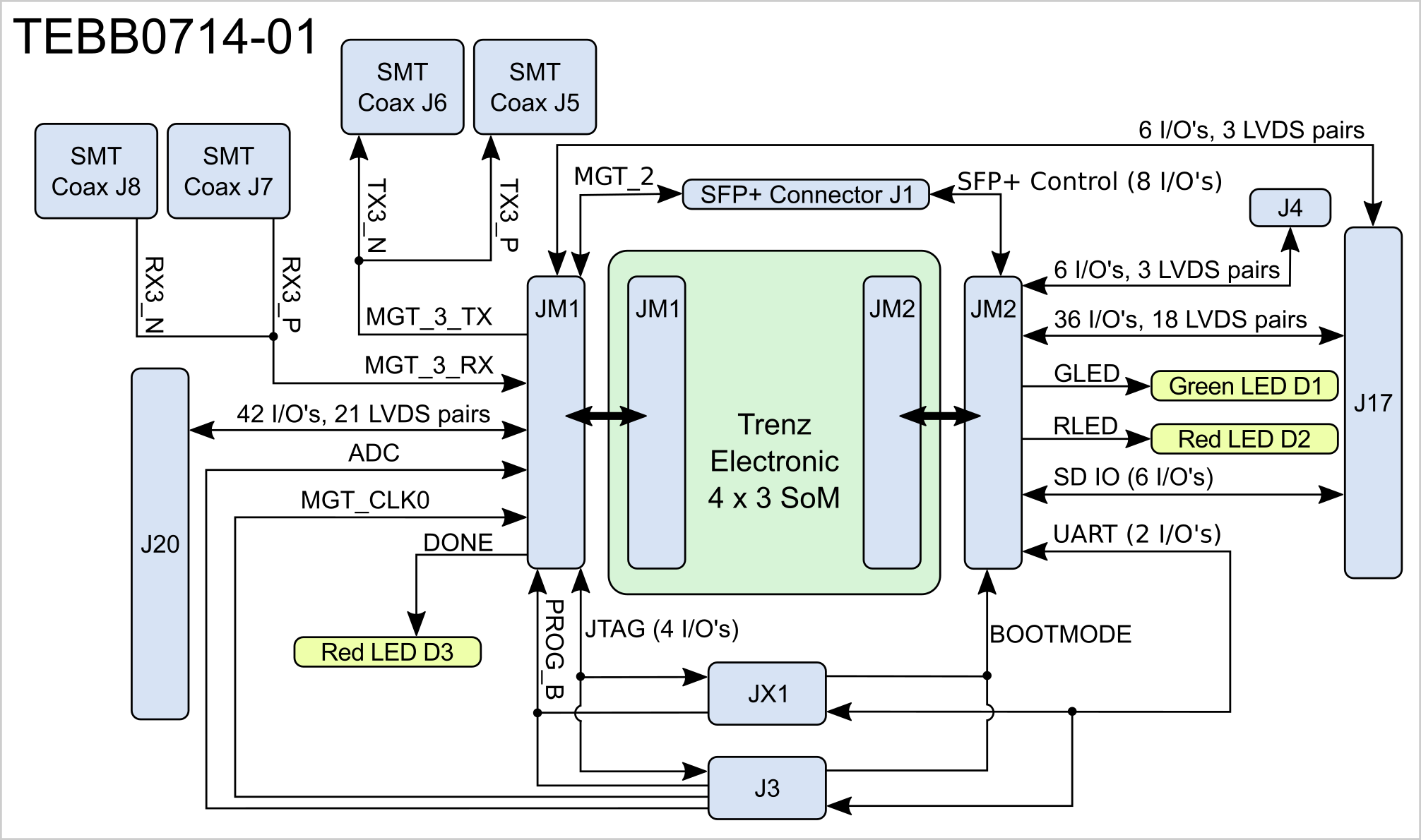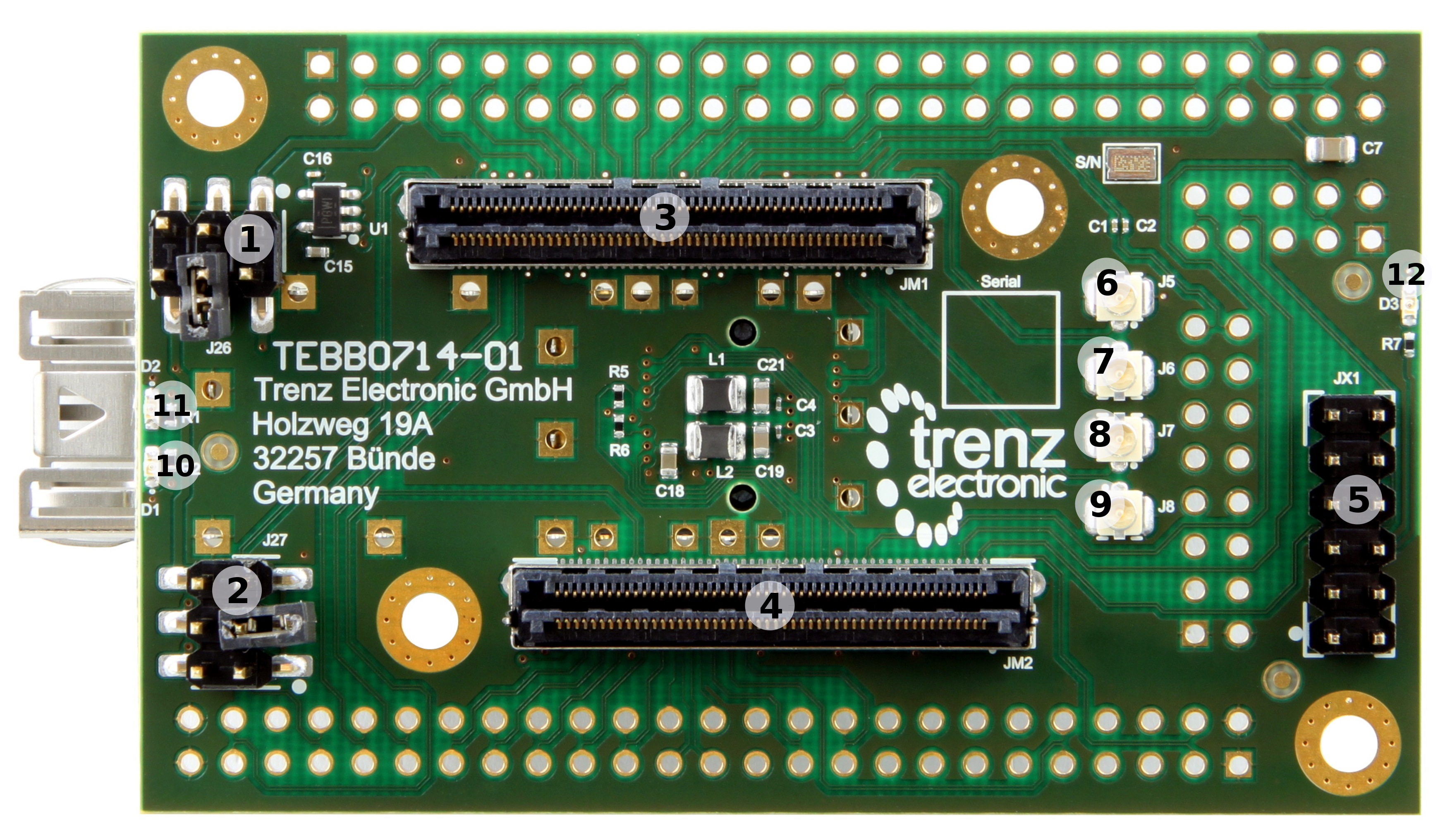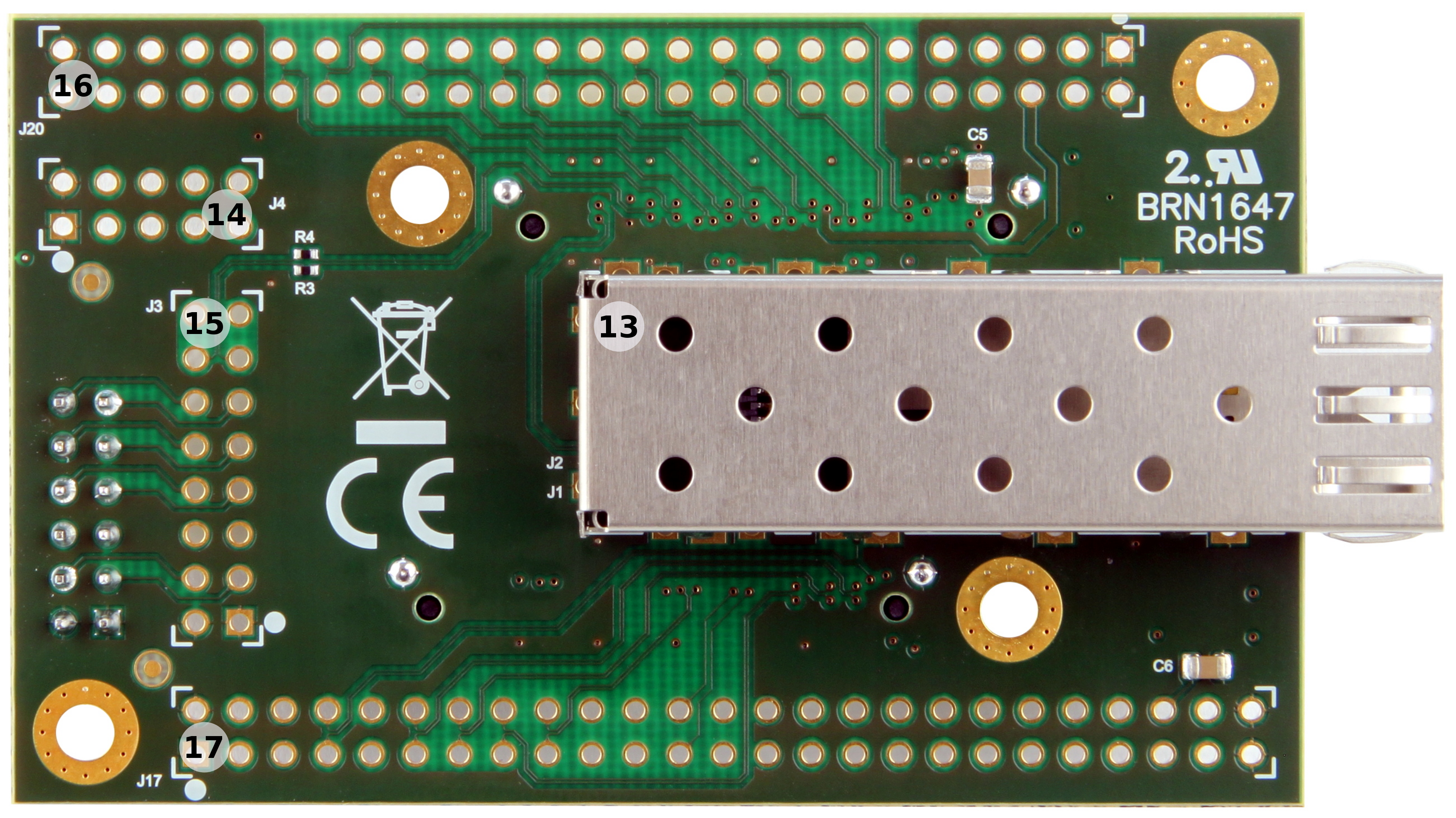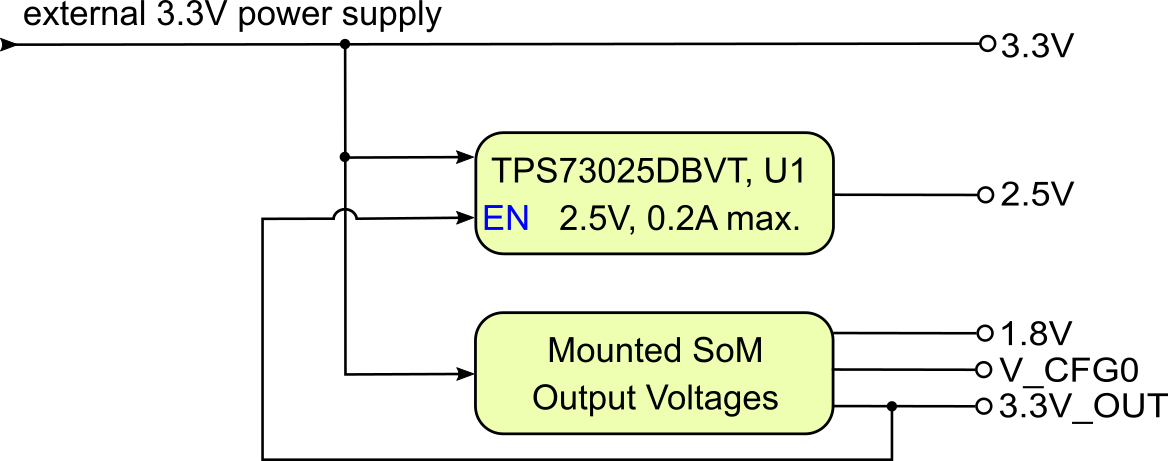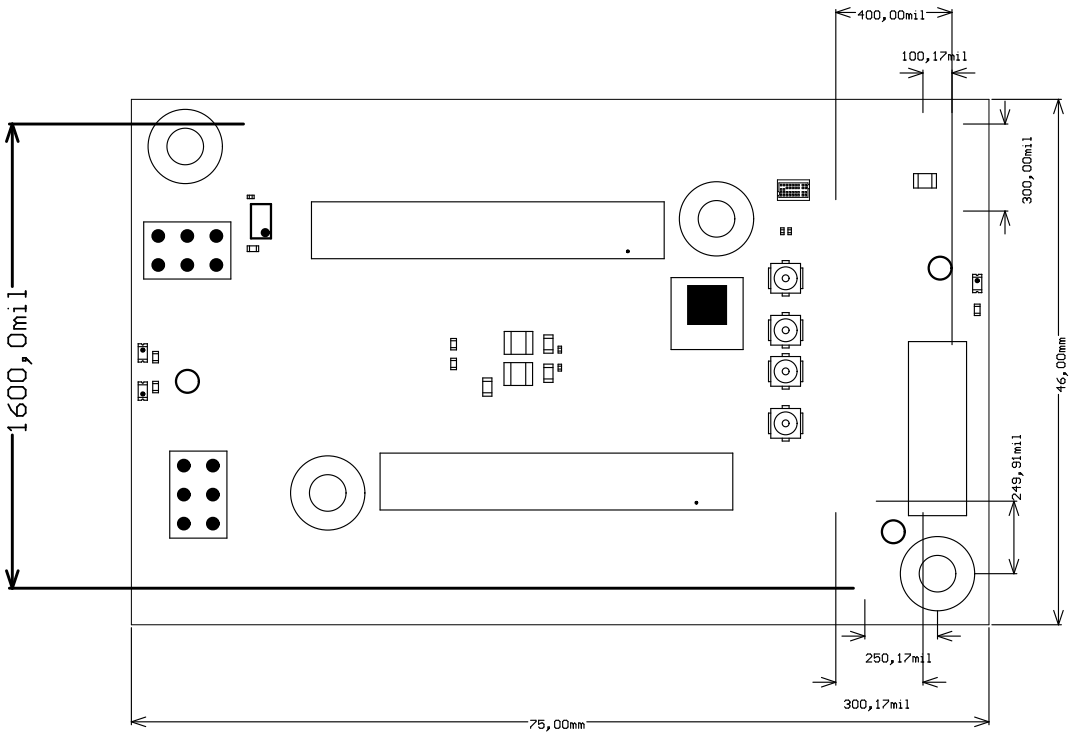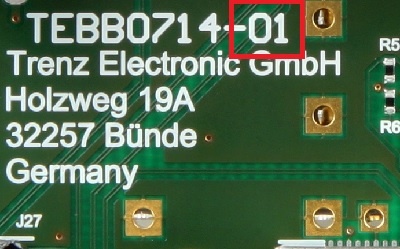Download PDF version of this document.
Table of Contents
Overview
The Trenz Electronic TEBB0714 is a Carrier Board for testing, evaluation and development purposes, especially for the Multi Gigabit Transceiver units of the TE0714 module. Although this base-board is dedicated to the TE0714 module, it is also compatible with other Trenz Electronic 4 x 3 cm SoMs. See page "4 x 3 cm carriers" to get information about the SoMs supported by the TEBB0714 Carrier Board.
This base-board provides also solder pads as place-holders for pin headers as option to get access to the PL I/O-bank pins and further of the mounted TE 4 x 3 SoM.
Key Features
- SFP+ connector (Enhanced small form-factor pluggable), support data transmission rates up to 10 Gbit/s
- 4 Hirose Ultra small SMT coaxial connectors, support data transmission rates up to 6 Gbit/s
- TE 4 x 3 cm SoM programmable by XMOD header (JX1)
- 2 x user LEDs routed to I/O-pins of the SoM
- Solder pads J17 and J20 for optional pin headers for access to SoM's PL I/O-bank pins, usable as LVDS pairs
- Solder pads J3 and J4 for optional pin headers for access to further interfaces and I/O's of the SoM
Additional assembly options are available for cost or performance optimization upon request.
Block Diagram
Figure 1: TEBB0714-01 Block Diagram.
Main Components
Figure 2: TEBB0714-01 Carrier Board.
- 6-pin header J26 for selecting PL-bank I/O voltage
- 6-pin header J27 for selecting XMOD/JTAG VCCIO
- Samtec Razor Beam™ LSHM-150 B2B connector, JM1
- Samtec Razor Beam™ LSHM-150 B2B connector, JM2
- XMOD header, JX1
- Ultra small SMT coaxial connector, J5
- Ultra small SMT coaxial connector, J6
- Ultra small SMT coaxial connector, J7
- Ultra small SMT coaxial connector, J8
- User LED D1 (green)
- User LED D2 (red)
- LED D3 (red) indicating FPGA's 'Programming DONE'-signal
- SFP+ Connector, J1
- 10-pin header solder pads J4 for access to SoM's PL I/O-banks (LVDS pairs possible)
- 16-pin header solder pads J3, JTAG/UART header ('XMOD FTDI JTAG Adapter'-compatible pin-assignment)
- 50-pin header solder pads J20 for access to SoM's PL I/O-banks (LVDS pairs possible)
- 50-pin header solder pads J17 for access to SoM's PL I/O-banks (LVDS pairs possible)
Initial Delivery State
Board is shipped in following configuration:
- VCCIO voltage selection jumpers are all set to 1.8 V.
- Pin headers (not soldered to the board, but included in the package as separate component)
Different delivery configurations are available upon request.
Signals, Interfaces and Pins
B2B Connector
With the TEBB0714 Carrier Board's Board-to-Board Connectors (B2B) the MIO- and PL I/O-bank's pins and further interfaces of the mounted SoM can be accessed. A large quantity of these I/O's are also usable as differential pairs. The connectors provide also VCCIO voltages to operate the I/O's properly.
Following table gives a summary of the available I/O's, interfaces and differential pairs of the B2B connectors JB1, JB2 and JB3:
| B2B Connector | Interfaces | Count of I/O's | Notes |
|---|---|---|---|
| JM1 | User I/O | 54 single ended or 27 differential | - |
| MGT lanes | 4 differential pairs, 2 lanes | - | |
| MGT reference clock input | 1 | - | |
| JTAG | 4 | - | |
| SoM control signals | 2 | 'PROG_B', 'DONE' | |
| ADC interface | 1 differential pair | - | |
| JM2 | User I/O | 36 single ended or 18 differential | - |
| SFP+ Interface control signals | 8 | - | |
| QSPI interface | 6 | - | |
| UART interface | 2 | - | |
| User LEDs | 2 | Red, Green | |
| SoM control signals | 1 | 'BOOTMODE' |
Table 1: General overview of PL I/O signals and SoM's interfaces connected to the B2B connectors.
On-board Pin Header
The TEBB0714 Carrier Board has 4 footprints as soldering pads to mount 2.54mm grid size pin headers to get access the PL I/O-bank's pins and further interfaces of the mounted SoM. With these pin headers, SoM's PL-I/O's are available to the user, a large quantity of these I/O's are also usable as differential pairs.
Following table gives a summary of the pin-assignment, available interfaces and functional I/O's of the pin headers:
| On-board Pin Header | Control Signals and Interfaces | Count of I/O's | Notes |
|---|---|---|---|
| J17 | User I/O | 36 single ended or 18 differential | - |
| QSPI interface | 6 | - | |
| J20 | User I/O | 42 single ended or 21 differential | - |
| J3 | JTAG | 4 | - |
| UART | 2 | - | |
| SoM control signals | 2 | 'BOOTMODE', 'PROG_B' | |
| ADC | 1 differential pair | - | |
| MGT reference clock input | 1 differential pair | AC decoupled on-board (100 nF capacitor) | |
| J4 | User I/O | 6 single ended or 3 differential | 3.3V, 3.3V_OUT voltage level available on header |
Table 2: General overview of PL I/O signals, SoM's interfaces and control signals connected to the on-board connectors.
SFP+ Connector
The TEBB0714 Carrier Board is equipped with one SFP+ connector J1 (board-rev. 01: Molex 74441-0001). The connector is embedded into a SFP cage J2 (board-rev. 01: Molex 74737-0009).
The differential RX/TX data lanes are connected to B2B connector JM1, the control-lines are connected to B2B connector JM2.
Following table describes the pin-assignment of the SFP+ connector in detail:
| SFP+ pin | Pin Schematic Name | B2B | FPGA Direction | Description | Note |
|---|---|---|---|---|---|
| Transmit Data + (pin 18) | MGT_TX2_P | JM1-14 | Output | SFP+ transmit data differential pair | - |
| Transmit Data - (pin 19) | MGT_TX2_N | JM2-16 | Output | - | |
| Receive Data + (pin 13) | MGT_RX2_P | JM1-7 | Input | SFP+ receive data differential pair | - |
| Receive Data - (pin 12) | MGT_RX2_N | JM1-9 | Input | - | |
| Receive Fault (pin 2) | SFP0_TX_FAULT | JM2-42 | Input | Fault / Normal Operation | High active logic |
| Receive disable (pin 3) | SFP0_TX_DIS | JM2-44 | Output | SFP Enabled / Disabled | Low active logic |
| MOD-DEF2 (pin 4) | SFP0_SDA | JM2-46 | BiDir | 2-wire Serial Interface data | 3.3V pull-up on-board |
| MOD-DEF1 (pin 5) | SFP0_SCL | JM2-48 | Output | 2-wire Serial Interface clock | 3.3V pull-up on-board |
| MOD-DEF0 (pin 6) | SFP0_M-DEF0 | JM2-40 | Input | Module present / not present | Low active logic |
| RS0 (pin 7) | SFP0_RS0 | JM2-38 | Output | Full RX bandwidth | Low active logic |
| LOS (pin 8) | SFP0_LOS | JM2-34 | Input | Loss of receiver signal | High active logic |
| RS1 (pin 9) | SFP0_RS1 | JM2-32 | Output | Reduced RX bandwidth | Low active logic |
Table 3: SFP+ connector pin-assignment.
Ultra Small SMT Coaxial Connectors
4 HIROSE Ultra Small Surface Mount Coaxial Connectors (up to 6 Gbit/s transmission rate) are present on the Carrier Board available for access to one MGT lane of the SoM. The connectors have the manufacturer designation 'U.FL-R-SMT-1', mating hight: 2.4 mm.
Each conductor of the RX and TX differential pair is routed to one coaxial connector:
| Connector Designator | Connected to | B2B Connector |
|---|---|---|
| J5 | MGT_TX3_P | JM1-8 |
| J6 | MGT_TX3_N | JM1-10 |
| J7 | MGT_RX3_P | JM1-1 |
| J8 | MGT_RX3_N | JM1-3 |
Table 4: Pin-assignment of the coaxial connectors.
JTAG Interface
JTAG access to the mounted SoM is provided through B2B connector JB2 and is also routed to the XMOD header JX1 and pin header J3. With the TE0790 XMOD USB2.0 to JTAG adapter, the device of the mounted SoM can be programed via USB2.0 interface.
JTAG Signal | B2B Connector Pin | XMOD Header JX1 | Pin Header J3 | Note |
|---|---|---|---|---|
| TCK | JM1-90 | JX1-4 | J3-4 | - |
| TDI | JM1-86 | JX1-10 | J3-10 | - |
| TDO | JM1-88 | JX1-8 | J3-8 | - |
| TMS | JM1-92 | JX1-12 | J3-12 | - |
Table 5: JTAG interface signals.
XMOD FTDI JTAG-Adapter Header JX1
The JTAG interface of the mounted SoM can be accessed via XMOD header JX1, so in use with the XMOD-FT2232H adapter-board TE0790 the mounted SoM can be programmed via USB2.0 interface. The TE0790 board provides also an UART interface to the SoM's Zynq device which can be accessed by the USB2.0 interface of the adapter-board while the signals between these serial interfaces will be converted.
Following table describes the signals and interfaces of the XMOD header JX1:
| Pin Schematic Name | XMOD Header JX1 Pin | B2B | Note |
|---|---|---|---|
| TCK | C (pin 4) | JM1-90 | - |
| TDO | D (pin 8) | JM1-88 | - |
| TDI | F (pin 10) | JM1-86 | - |
| TMS | H (pin 12) | JM1-92 | - |
| B14_L25 | A (pin 3) | JM2-97 | UART-TX (transmit line) |
| B14_L0 | B (pin 7) | JM2-99 | UART-RX (receive line) |
| BOOTMODE | E (pin 9) | JM2-100 | - |
| PROG_B | G (pin 11) | JM1-94 | - |
Table 6: XMOD header JX1 signals and connections.
When using XMOD FTDI JTAG Adapter TE0790, the adapter-board's VCC and VCCIO will be sourced by the Carrier Board's and module's 3.3V supply voltage. Set the XMOD DIP-switch with the setting:
| XMOD DIP-switches | Position |
|---|---|
| Switch 1 | ON |
| Switch 2 | OFF |
| Switch 3 | OFF |
| Switch 4 | OFF |
Table 7: XMOD adapter board DIP-switch positions for voltage configuration.
The I/O-voltage of the XMOD adapter board with the schematic name 'V_CFG' and pin-name 'VIO' (pin 6) on XMOD header JX1 can be selected via Jumper J27:
V_CFG Value | Jumper J27 Setting | Note |
|---|---|---|
| 1.8V | pins 1-2 connected | Module's output voltage. |
| V_CFG0 | pins 3-4 connected | Internal module VCCIO: 3.3V or 1.8V, depending on TE0714 module configuration. |
| 3.3V_OUT | pins 5-6 connected | Module's output voltage. |
Table 8: Setting of reference I/O-voltage XMOD header.
Use Xilinx compatible TE0790 adapter board (designation TE-0790-xx with out 'L') to program the Xilinx Zynq devices.
The TE0790 adapter board's CPLD have to be configured with the Standard variant of the firmware. Refer to the TE0790 Resources Site for further information and firmware download.
JTAG/UART Header J3
As alternative to the XMOD header JX1, on the Carrier Board pin header J3 is present, which has a XMOD header-compatible pin-assignment, but also 4 additional pins as differential pairs to supply the mounted SoM with an external MGT reference clock signal and as differential analog signal input:
| Pin Schematic Name | Header J3 Pin | B2B | Note |
|---|---|---|---|
| TCK | 4 | JM1-90 | - |
| TDO | 8 | JM1-88 | - |
| TDI | 10 | JM1-86 | - |
| TMS | 12 | JM1-92 | - |
| B14_L25 | 3 | JM2-97 | UART-TX (transmit line) |
| B14_L0 | 7 | JM2-99 | UART-RX (receive line) |
| BOOTMODE | 9 | JM2-100 | - |
| PROG_B | 11 | JM1-94 | - |
| XADC_P | 13 | JM1-25 | Analog input differential pair |
| XADC_N | 14 | JM1-27 | |
| CLK0_N | 15 | JM1-4 | AC decoupled on-board (100 nF capacitor) |
| CLK0_P | 16 | JM1-2 |
Table 9: JTAG/UART header J3 signals and connections.
UART Interface
UART interface is available on B2B connector JM2. With the TE0790 XMOD USB2.0 adapter, the UART signals can be converted to USB2.0 interface signals:
| UART Signal Schematic Name | B2B | XMOD Header JX1 | Pin Header J3 | Note |
|---|---|---|---|---|
| B14_L0 | JM2-99 | JX1-7 | J3-7 | UART-RX (receive line) |
| B14_L25 | JM2-97 | JX1-3 | J3-3 | UART-TX (transmit line) |
Table 10: UART interface signals.
QSPI Interface
The QSPI interface (if available) of the mounted SoM is routed to the pin header J17. The reference I/O-voltage of the module have to be noticed when using this interface.
| SD IO Signal Schematic Name | B2B | Pin Header J17 | Note |
|---|---|---|---|
| SPI-DQO | JM2-68 | J17-24 | QSPI data |
| SPI-DQ1 | JM2-71 | J17-27 | QSPI data |
| SPI-DQ2 | JM2-73 | J17-28 | QSPI data |
| SPI-DQ3 | JM2-70 | J17-23 | QSPI data |
| SPI-CLK | JM2-67 | J17-26 | QSPI clock |
| SPI_CS | JM2-69 | J17-25 | QSPI chip select |
Table 11: QSPI interface signals.
On-board Peripherals
On-board LEDs
The on-board LEDs are available to the user and can be used to indicate system status and activities:
| LED Designator | Color | Pin Schematic Name | B2B Connector | Indicating |
|---|---|---|---|---|
| D1 | green | GLED | JM2-26 | Available to user. |
| D2 | red | RLED | JM2-24 | Available to user. |
| D3 | red | DONE | JM1-96 | FPGA module programmed properly. |
Figure 12: On-board LEDs
VCCIO Selection Jumper
On the TEBB0714 Carrier Board the PL-bank I/O voltage (schematic name 'VCCIO34') can be selected by the jumper J26.
VCCIO34 Value | Jumper J26 Setting | Note |
|---|---|---|
| 1.8V | pins 1-2 connected | Module's output voltage. |
| 2.5V | pins 3-4 connected | Voltage generated by on-board LDO U1. |
| 3.3V_OUT | pins 5-6 connected | Module's output voltage. |
Table 13: Base-board PL-bank I/O voltage setting.
Take care of the VCCO voltage ranges of the particular PL IO-banks (HR, HP) of the mounted SoM, otherwise damages may occur to the FPGA. Therefore, refer to the TRM of the mounted SoM to get the specific information of the voltage ranges.
It is recommended to set and measure the PL IO-bank supply-voltages before mounting of TE 4 x 3 module to avoid failures and damages to the functionality of the mounted SoM.
Power and Power-On Sequence
Power Consumption
The maximum power consumption of the Carrier Board depends mainly on the mounted SoM's FPGA design running on the Zynq device.
Xilinx provide a power estimator excel sheets to calculate power consumption. It's also possible to evaluate the power consumption of the developed design with Vivado. See also Trenz Electronic Wiki FAQ.
| Power Input | Typical Current |
|---|---|
| 3.3V | TBD* |
Table 14: Typical power consumption.
* TBD - To Be Determined soon with reference design setup.
Power supply with minimum current capability of 3A for system startup is recommended.
Power Supply
Power supply with minimum current capability of 3A at 3.3V for system startup is recommended.
The on-board voltages of the carrier board will be powered up with an external power-supply with nominal voltage of 3.3V.
The external power-supply can be connected to the board by the following pins:
| Connector | 3.3V pin | GND pin |
|---|---|---|
| JX1 | JX1-5, JX1-6, | JX1-1, JX1-2 |
| J3 | J3-5, J3-6 | J3-1, J3-2 |
| J4 | J4-5 | J4-1, J4-2 |
| J20 | J20-5, J20-46 | J20-1 , J20-2 , J20-49 , J20-50 |
| J17 | J17-5, J17-46 | J17-1 , J17-2 , J17-49 , J17-50 |
Table 15: Connector pins capable for external 3.3V power supply
Power Distribution Dependencies
The PL-bank I/O voltages 1.8V, 2.5V and 3.3V will be available after the mounted SoM's 3.3V voltage level has reached stable state on B2B-connector pins JM1-83 and JM2-54, meaning that all on-module voltages have become stable and module is properly powered up.
Following diagram shows the distribution of the external input voltage of nominal 3.3V to the components:
Figure 3: Board power distribution diagram.
Power Rails
The voltage direction of the power rails is from board and on-board connectors' view:
| Module Connector (B2B) Designator | VCC / VCCIO | Direction | Pins | Notes |
|---|---|---|---|---|
| JM1 | 3.3V | Out | 97, 99 | 3.3V module supply voltage |
| 3.3V_OUT | In | 83 | 3.3V module output voltage | |
| VCCIO34 | Out | 61 | PL IO-bank VCCIO | |
| JM2 | 1.8V | In | 18 | 1.8V module output voltage |
| 3.3V_OUT | Out | 54 | 3.3V module output voltage | |
| V_CFG0 | In | 53 | Internal module VCCIO: 3.3V or 1.8V |
Table 16: Power pin description of B2B module connector.
| On-board Pin Header Designator | VCC / VCCIO | Direction | Pins | Notes |
|---|---|---|---|---|
| J17 | 3.3V | In / Out | 5, 46 | 3.3V external supply voltage |
| V_CFG | Out | 6, 45 | VCCIO, depends on jumper 27 settings | |
| J20 | 3.3V | In / Out | 5, 46 | 3.3V external supply voltage |
| VCCIO34 | In / Out | 6, 45 | PL IO-bank VCCIO, depends on Jumper settings |
Table 17: Power Pin description of on-board connector.
| Jumper / Header Designator | VCC / VCCIO | Direction | Pins | Notes |
|---|---|---|---|---|
| J26 | VCCIO34 | In | 1, 3, 5 | - |
| 1.8V | Out | 2 | - | |
| 2.5V | Out | 4 | - | |
| 3.3V_OUT | Out | 6 | - | |
| J27 | V_CFG | In | 1, 3, 5 | - |
| 1.8V | Out | 2 | - | |
| V_CFG0 | Out | 4 | - | |
| 3.3V_OUT | Out | 6 | - |
Table 18: Power Pin description of VCCIO selection jumper pin header.
| JTAG/UART Header Designator | VCC / VCCIO | Direction | Pins | Notes |
|---|---|---|---|---|
| JX1 (XMOD) | 3.3V | Out | 5 | Connected to 3.3V external supply voltage |
| VIO | Out | 6 | Connected to 'V_CFG', depends on jumper 27 settings | |
| J3 | 3.3V | Out | 5 | Connected to 3.3V external supply voltage |
| V_CFG | Out | 6 | VCCIO, depends on jumper 27 settings |
Table 19: Power pin description of XMOD/JTAG Connector.
Board to Board Connectors
Technical Specifications
Absolute Maximum Ratings
| Parameter | Min | Max | Units | Notes |
|---|---|---|---|---|
Vin supply voltage | 3.135 | 3.465 | V | 3.3V supply-voltage ± 5% |
Storage Temperature | -40 | 85 | °C | WL-SMCW SMD chip LED data sheet |
Table 20: Board absolute maximum ratings.
Recommended Operating Conditions
| Parameter | Min | Max | Units | Notes |
|---|---|---|---|---|
| Vin supply voltage | 3.135 | 3.465 | V | - |
| Operating temperature | -40 | +85 | °C | Molex 74441-0001 Product Specification |
Table 21: Module recommended operating conditions.
Operating Temperature Ranges
Industrial grade: -40°C to +85°C.
The TEBA0841 Carrier Board itself is capable to be operated at industrial grade temperature range.
Please check the operating temperature range of the mounted SoM, which determine the relevant operating temperature range of the overall system.
Physical Dimensions
Board size: PCB 46mm × 75mm. Notice that some parts the are hanging slightly over the edge of the PCB like the the SFP+ connector, which determine the total physical dimensions of the carrier board. Please download the assembly diagram for exact numbers.
Mating height of the module with standard connectors: 8mm
PCB thickness: ca. 1.65mm
Highest part on the PCB is the SFP+ connector, which has an approximately 11.3 mm overall hight. Please download the step model for exact numbers.
The dimensions are given in mm and mil (milli inch).
Figure 4: Board physical dimensions drawing.
Revision History
Hardware Revision History
| Date | Revision | Notes | PCN | Documentation Link |
|---|---|---|---|---|
| - | 01 |
| - | TEBB0714-01 |
Table 22: Module hardware revision history.
Hardware revision number can be found on the PCB board together with the module model number separated by the dash.
Figure 5: Board hardware revision number.
Document Change History
Date | Revision | Contributors | Description |
|---|---|---|---|
| Ali Naseri, Jan Kumann |
|
Table 23: Document change history.
Disclaimer
Data Privacy
Please also note our data protection declaration at https://www.trenz-electronic.de/en/Data-protection-Privacy
Document Warranty
The material contained in this document is provided “as is” and is subject to being changed at any time without notice. Trenz Electronic does not warrant the accuracy and completeness of the materials in this document. Further, to the maximum extent permitted by applicable law, Trenz Electronic disclaims all warranties, either express or implied, with regard to this document and any information contained herein, including but not limited to the implied warranties of merchantability, fitness for a particular purpose or non infringement of intellectual property. Trenz Electronic shall not be liable for errors or for incidental or consequential damages in connection with the furnishing, use, or performance of this document or of any information contained herein.
Limitation of Liability
In no event will Trenz Electronic, its suppliers, or other third parties mentioned in this document be liable for any damages whatsoever (including, without limitation, those resulting from lost profits, lost data or business interruption) arising out of the use, inability to use, or the results of use of this document, any documents linked to this document, or the materials or information contained at any or all such documents. If your use of the materials or information from this document results in the need for servicing, repair or correction of equipment or data, you assume all costs thereof.
Copyright Notice
No part of this manual may be reproduced in any form or by any means (including electronic storage and retrieval or translation into a foreign language) without prior agreement and written consent from Trenz Electronic.
Technology Licenses
The hardware / firmware / software described in this document are furnished under a license and may be used /modified / copied only in accordance with the terms of such license.
Environmental Protection
To confront directly with the responsibility toward the environment, the global community and eventually also oneself. Such a resolution should be integral part not only of everybody's life. Also enterprises shall be conscious of their social responsibility and contribute to the preservation of our common living space. That is why Trenz Electronic invests in the protection of our Environment.
REACH, RoHS and WEEE
REACH
Trenz Electronic is a manufacturer and a distributor of electronic products. It is therefore a so called downstream user in the sense of REACH. The products we supply to you are solely non-chemical products (goods). Moreover and under normal and reasonably foreseeable circumstances of application, the goods supplied to you shall not release any substance. For that, Trenz Electronic is obliged to neither register nor to provide safety data sheet. According to present knowledge and to best of our knowledge, no SVHC (Substances of Very High Concern) on the Candidate List are contained in our products. Furthermore, we will immediately and unsolicited inform our customers in compliance with REACH - Article 33 if any substance present in our goods (above a concentration of 0,1 % weight by weight) will be classified as SVHC by the European Chemicals Agency (ECHA).
RoHS
Trenz Electronic GmbH herewith declares that all its products are developed, manufactured and distributed RoHS compliant.
WEEE
Information for users within the European Union in accordance with Directive 2002/96/EC of the European Parliament and of the Council of 27 January 2003 on waste electrical and electronic equipment (WEEE).
Users of electrical and electronic equipment in private households are required not to dispose of waste electrical and electronic equipment as unsorted municipal waste and to collect such waste electrical and electronic equipment separately. By the 13 August 2005, Member States shall have ensured that systems are set up allowing final holders and distributors to return waste electrical and electronic equipment at least free of charge. Member States shall ensure the availability and accessibility of the necessary collection facilities. Separate collection is the precondition to ensure specific treatment and recycling of waste electrical and electronic equipment and is necessary to achieve the chosen level of protection of human health and the environment in the European Union. Consumers have to actively contribute to the success of such collection and the return of waste electrical and electronic equipment. Presence of hazardous substances in electrical and electronic equipment results in potential effects on the environment and human health. The symbol consisting of the crossed-out wheeled bin indicates separate collection for waste electrical and electronic equipment.
Trenz Electronic is registered under WEEE-Reg.-Nr. DE97922676.
